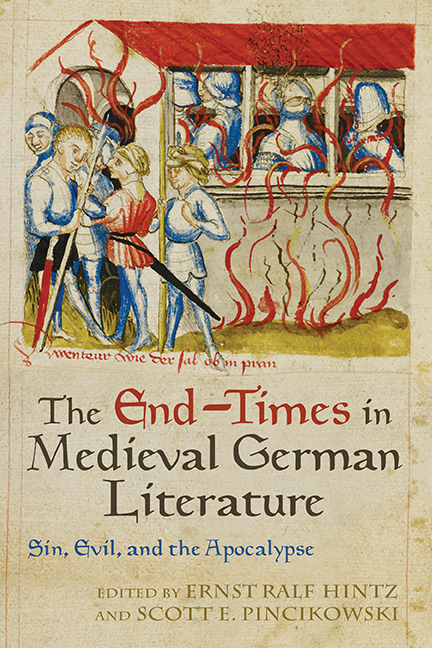Book contents
- Frontmatter
- Dedication
- Contents
- Acknowledgments
- Introduction
- 1 Thiu wirsa giburd: Cain’s Legacy, Original Sin, and the End of the World in the Old Saxon Genesis
- 2 The Heliand Revisited: Spiritual Transgendering and the Defiance of Evil
- 3 The Beginning of the End: Binary Dynamics and Initiative in Hartmann von Aue’s Gregorius
- 4 Poetic Reflections in Medieval German Literature on Tragic Conflicts, Massive Death, and Armageddon
- 5 Beyond Good and Evil: Apocalyptic Vision without Judgment in the Nibelungenlied. An Essay
- 6 End-Times in the Hall: The Modern Reception of the Apocalyptic Ending of the Nibelungenlied
- 7 Past Present, Future Present? Visualizing Arthurian Romance and the Beholder’s Share in a World That Refuses to End
- 8 Ich diene und wirbe / biz ich gar verdirbe: Lovesickness, Apocalypse, and the End-Times in Mauritius von Craûn and Das Nibelungenlied
- 9 The Slippery Concept of Evil in Hartmann von Aue’s Erec and Iwein
- 10 Wigamur’s Lessons on the Complexity of Evil
- 11 The Miracles of the Antichrist
- 12 Monsters and Monstrosities in the Pamphlet Wars of the Reformation
- Notes on the Contributors
- Index
9 - The Slippery Concept of Evil in Hartmann von Aue’s Erec and Iwein
Published online by Cambridge University Press: 21 March 2020
- Frontmatter
- Dedication
- Contents
- Acknowledgments
- Introduction
- 1 Thiu wirsa giburd: Cain’s Legacy, Original Sin, and the End of the World in the Old Saxon Genesis
- 2 The Heliand Revisited: Spiritual Transgendering and the Defiance of Evil
- 3 The Beginning of the End: Binary Dynamics and Initiative in Hartmann von Aue’s Gregorius
- 4 Poetic Reflections in Medieval German Literature on Tragic Conflicts, Massive Death, and Armageddon
- 5 Beyond Good and Evil: Apocalyptic Vision without Judgment in the Nibelungenlied. An Essay
- 6 End-Times in the Hall: The Modern Reception of the Apocalyptic Ending of the Nibelungenlied
- 7 Past Present, Future Present? Visualizing Arthurian Romance and the Beholder’s Share in a World That Refuses to End
- 8 Ich diene und wirbe / biz ich gar verdirbe: Lovesickness, Apocalypse, and the End-Times in Mauritius von Craûn and Das Nibelungenlied
- 9 The Slippery Concept of Evil in Hartmann von Aue’s Erec and Iwein
- 10 Wigamur’s Lessons on the Complexity of Evil
- 11 The Miracles of the Antichrist
- 12 Monsters and Monstrosities in the Pamphlet Wars of the Reformation
- Notes on the Contributors
- Index
Summary
Evil assumes various shapes in medieval epics. Each shape corresponds to its own form of conflict.
—Kenneth L. SchmitzVIOLENCE AND FIGHTING are dominant features in medieval narratives, and as we all know, much of the fighting, jousting, and knightly deeds serve to reveal “ideal, chivalrous forms of behavior both in combat and in non-combative social situations.” What is of interest to me in this article are the instances of violence that are excessive, which necessarily raises the question about intentio—that is, what motivated the aggressor to employ such forceful actions: is he simply overstepping social norms, is he acting in self-defense, or is he acting from a place of evil? It is the latter that I will investigate here in Hartmann von Aue's Erec and Iwein to determine when a cruel act is perceived as being truly evil or “merely” violent, and if different standards are applied to figures based on their social status as well as the perceived difference of their actions. This will expose several cultural attitudes toward those whose acts are deemed evil and need to be punished severely and those who receive a figurative slap on the hand in spite of their use of excessive violence.
The term “evil” covers a broad range of meanings. The Oxford English Dictionary lists the following as primary definitions: “the antithesis of good; a description of what is morally depraved, bad, wicked, vicious, mischievous, painful, hurtful, prejudicial or disastrous; that which is morally or physically evil; sin, wickedness; the act of doing or of tending to do harm; to cause discomfort, pain, or trouble; it is used to describe the Devil or evil spirits, or someone's reputation or intention.” “Evil” and “good” are often conveyed in medieval texts by means of dark and light imagery, respectively. Boethius in his Consolation of Philosophy makes frequent use of light and dark imagery in his analysis of good and evil, to name but one influential medieval person. God, the ultimate form of Good, is commonly rendered in the brightest light: “The natural cosmic symbol for God was the transforming radiance, the Divine Splendour (illustratio) of which Dionysos wrote.” Other literary texts that come to mind when contemplating the notion of evil are Beowulf and the Nibelungenlied. Grendel and his mother represent the dark evil in their formless yet raw power.
- Type
- Chapter
- Information
- The End-Times in Medieval German LiteratureSin, Evil, and the Apocalypse, pp. 190 - 215Publisher: Boydell & BrewerPrint publication year: 2019



